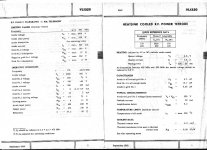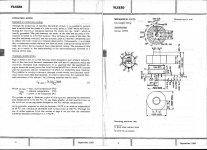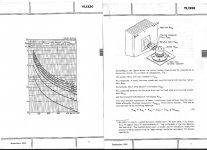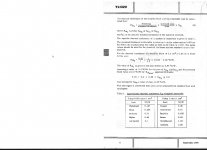I am surprised,
That no one seems to make a plug in base (perhaps 20mm high) for the 6C33C that lifts it off the Russian type socket out of the amp chassis and a cooler that deflects the heat away from the top plate...
This is a heat issue to think about...you can cook toast with these tubes.. 🙂
Regards
M. Gregg
I found out the hard way that expensive teflon septars get eaten for breakfast by 6C33 🙁 Luckily I turned mine into GM70 sockets so all was not lost 🙂 The Russian and Chinese ceramic sockets are slightly better but the ones to find are vintage Johnsons . Even running at 40w diss I found the 6C33 conducted so much heat into the socket pins that the sockets needed a reflow every few months with the Chinese/Russian sockets , especially at the heater pins . Better off addressing the problem by wrapping a few turns of 0.8mm solid copper wire around the solder contacts then tinning with a big blob of solder to act as a heatsink
316A
Radiation is 2-way thing: from anode to environment, and from environment to anode. Gradient of temperatures matters. The cooler is environment, the better it absorbs radiation from anode. That's why blackened heatsinks around tubes work. They absorb radiated from anodes heat energy and dissipate it by convection radiating less back to anode.
Exactly. And based on these facts, I would NOT design a cooler to be in direct contact with the glass. I would design a larger diameter cylinder with fins both inside and outside. Then stack effect would provide convection cooling on both inside and outside fins. Like the double-sided heatsinks we put on SS devices, only cylindrical.
And carrying it one step further, the cooler may not be necessary or beneficial. If the cooler absorbs radiation well, it will get hot unless force-cooled by a fan. As it gets hotter, it will absorb less radiation (remember the radiated/absorbed energy is proportional to deltaT). You may get more energy transfer by placing a large black cage on the chassis or simply placing the chassis in a room with flat black walls. The walls will absorb a lot more radiated energy while staying cool.
Edit: Now that I look at it again, the picture in your OP is very close to the principle I described. It has air circulation both inside and outside, with fairly high surface area for convection. Very limited contact with the glass.
Last edited:
Edit: Now that I look at it again, the picture in your OP is very close to the principle I described. It has air circulation both inside and outside, with fairly high surface area for convection. Very limited contact with the glass.
I removed it from some military transceiver tightly packed inside. The idea was to use such coolers for 7 - channel tube amp, you may see it on the picture around 6S19P tube, the amp would need 14 such tubes. I gave up the idea.
arent 6c19p 's hard glass and €1.50 each shipped ? they are suposed to be run red plated my guess is there is where the 500H lifetime comes from
😀
big deal blowing up €1.50 tube 😀 replacing all in your amp would set you back about what a good el34 costs
😀
big deal blowing up €1.50 tube 😀 replacing all in your amp would set you back about what a good el34 costs
big deal blowing up €1.50 tube 😀 replacing all in your amp would set you back about what a good el34 costs
I prefer triode connected 6P15P. With 14 of El34 there would be a huge amplifier. Or 7 monoblocks per channel, so home theater will need a separate control room for amps. 😀
ChrisA, the quirky 'water cooled' glass-envelope valve setup would typically provide a much better heatsinking environment for the anode than normal free air convection. The glass is partially opaque to the majority of the IR heat transfer, and water is fully opaque, and given that the water is not allowed to generally heat up, and is circulated, then conductive heat transfer wins hands down, and so the anode would run at a lower temp.
Sadly, the Pearl main article on their cooler performance is seriously lacking in scientific experimental transparancy. The articles makes many references to other articles, but I don't see the tech report that shows how they measured their performance. Measuring temperature of glass tubes is fraught with problems, and the Cornell Thermatron is probably a better technique, but not used by Pearl. And the Pearl article reference to Kraus and Bar-Cohen is also poor, as that book takes just a very glib stance, which is not the full picture available nowadays, and lies at the heart of the heat transfer mechanism. Perhaps a FEA would be a good path to take nowadays.
Sadly, the Pearl main article on their cooler performance is seriously lacking in scientific experimental transparancy. The articles makes many references to other articles, but I don't see the tech report that shows how they measured their performance. Measuring temperature of glass tubes is fraught with problems, and the Cornell Thermatron is probably a better technique, but not used by Pearl. And the Pearl article reference to Kraus and Bar-Cohen is also poor, as that book takes just a very glib stance, which is not the full picture available nowadays, and lies at the heart of the heat transfer mechanism. Perhaps a FEA would be a good path to take nowadays.
I found out the hard way that expensive teflon septars get eaten for breakfast by 6C33 🙁 Luckily I turned mine into GM70 sockets so all was not lost 🙂 The Russian and Chinese ceramic sockets are slightly better but the ones to find are vintage Johnsons . Even running at 40w diss I found the 6C33 conducted so much heat into the socket pins that the sockets needed a reflow every few months with the Chinese/Russian sockets , especially at the heater pins . Better off addressing the problem by wrapping a few turns of 0.8mm solid copper wire around the solder contacts then tinning with a big blob of solder to act as a heatsink
316A
I think the best way is to mount them in a window box with flying leads outside the house..
Then they can be wind cooled... 🙂
Im just thinking about a Centrifugal fan mounted in the middle of the 6c33c's blowing across the top of the top plate in all directions...So it sucks out of the chassis...
This way.... [I I I I I I I I ]
Got to be worth a try just for fun..
Regards
M. Gregg
Regards the fan,
I am thinking 20-30mm high with an aluminium top plate so it cools the bottom of the tubes and top plate of the amp...sucking heat out of the amp at the same time..
With a bit of luck it will be quiet...if I can find one..
Regards
M. Gregg
I am thinking 20-30mm high with an aluminium top plate so it cools the bottom of the tubes and top plate of the amp...sucking heat out of the amp at the same time..
With a bit of luck it will be quiet...if I can find one..
Regards
M. Gregg
Just my $0.02.....
I used to own a Fender Super Reverb guitar amp, 2 x 6L6. As a combo amp the chassis was upside down, and a half hour running it would make the chassis too hot to touch.
I mounted a small (3.5" ??) quiet low-flow boxer fan blowing toward the chassis from the preamp side. With the fan on, the chassis only got warm.
Dunno what effect it had on IR from the glow, but obviously it took the hot air that would have convected upward and just quietly blew it away.
I drilled a blade-diameter-sized hole in the cabinet, then mounted the fan guard on the outside and the fan on the inside.
For hi-fi amps, I like that idea of air vents around the tube sockets along with a fan to pressurize the chassis. Just move the hot air away from the tubes. 😀
I used to own a Fender Super Reverb guitar amp, 2 x 6L6. As a combo amp the chassis was upside down, and a half hour running it would make the chassis too hot to touch.
I mounted a small (3.5" ??) quiet low-flow boxer fan blowing toward the chassis from the preamp side. With the fan on, the chassis only got warm.
Dunno what effect it had on IR from the glow, but obviously it took the hot air that would have convected upward and just quietly blew it away.
I drilled a blade-diameter-sized hole in the cabinet, then mounted the fan guard on the outside and the fan on the inside.
For hi-fi amps, I like that idea of air vents around the tube sockets along with a fan to pressurize the chassis. Just move the hot air away from the tubes. 😀
Another piece of the jigsaw to better understanding thermal radiation transfer from the plate and IR transparency and emissivity of the glass comes with Jeff West's comment on why MOV coated their KT's with graphite inner surface. I'm thinking the main impact is the better heat transfer away from the valve by radiation from the large area 'black' glass surface.
Why are some power tubes blackened??? - Page 2 - The Gear Page
Why are some power tubes blackened??? - Page 2 - The Gear Page
In the final analysis I must trust the military and their use of IERC coolers. When lives are at stake, it is quite a different situation than when only listening pleasure is the outcome. I am a disabled former MI officer and I know full well the results of inattention to details under combat conditions. Regards
Sadly, the Pearl main article on their cooler performance is seriously lacking in scientific experimental transparancy. The articles makes many references to other articles, but I don't see the tech report that shows how they measured their performance. Measuring temperature of glass tubes is fraught with problems, and the Cornell Thermatron is probably a better technique, but not used by Pearl. And the Pearl article reference to Kraus and Bar-Cohen is also poor, as that book takes just a very glib stance, which is not the full picture available nowadays, and lies at the heart of the heat transfer mechanism. Perhaps a FEA would be a good path to take nowadays.
I measured glass temp using very carefully positioned, very small thermocouples.
As to the Thermatron: that was a custom built part, hardly the sort of thing that hifi sales potential would justify.
The point however is that PEARL coolers provide the same sorts of temperature reductions and hot spot elimination repeatedly shown to extend tube life.
These days infrared thermography is a useful tool but with a learning curve. I might well rent a FLIR camera late next year and do some work.
Glass temp is only part of the picture. I would be much more interested in measuring the anode temp as an indication of how well any cooling technique is working. A tube manufacturer could easily put a thermocouple on the anodes of a few tubes for that purpose.
Review the thread to see just low is the correlation between envelope temp and anode temp reduction.
I did follow the entire thread and read everyone's opinions. I stand by my statements above.
I can easily devise a tube "cooler" that decreases glass temp and increases anode temp.
I can easily devise a tube "cooler" that decreases glass temp and increases anode temp.
That sounds like an interesting exercise, and particularly if it's an easy one. So . . . ? ?
Put a conductive, but reflective inside heatsink tightly on glass, that's it. 😉
An unblackened, that is bright, copper cooler fitted to an 813 running a 260C hot spot effects no bulb cooling whatever. FYI . . .
- Home
- Amplifiers
- Tubes / Valves
- Heatsinks for tubes?



